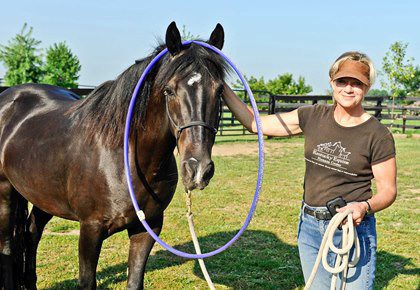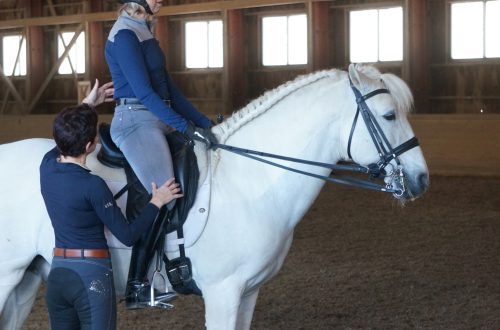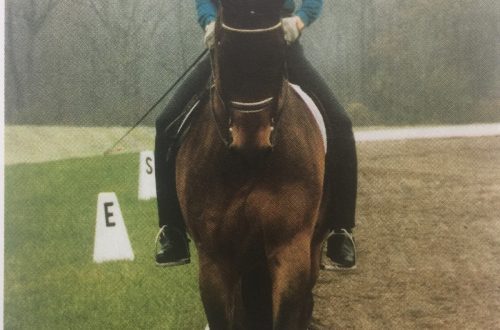
Horse Training: The Difference Between Habituation and Learned Helplessness
Horse Training: The Difference Between Habituation and Learned Helplessness
Question
At the seminar, I saw how the trainer taught the mare to the “terrible” subject. When he finished, the horse looked like he just gave up, went into himself, etc. I thought it was more like “learned helplessness” than habituation. Approaches that can lead to learned helplessness [1] seem unethical. Is it possible to desensitize a horse in a friendly way?
Response
Unfortunately, in the field of horse training, as, by the way, dogs, there has always been a lot of controversy in the field of misapplication of scientific principles and terminology. The question asked provides an opportunity to explain the differences in these concepts and the consequences of applying the corresponding methods in working with animals.
scientific concept addictive is a gradual decrease in the response to a stimulus over time. In the equine world, we most often think of this habituation as habituation to stimuli to which horses have an innate natural response. If the horse’s state upon repeated exposure to the stimulus is below the threshold at which he tries to escape or falls into a state of panic, then the reactions of the horse to the stimulus gradually decrease and may disappear. At the same time, we can say that the horse is “accustomed to the stimulus.”
I recently saw this in a 24 hour horse video. The horse was brought to a new stable and placed in a stall next to a very noisy thermal heater. The first couple of times when the heater “shuddered”, the horse became frightened and retreated to the far corner of the stall, where it froze in an anxious pose, looking towards the heater. Over the course of 24 hours, her reaction to turning on the heater became less and less noticeable – after about 12 hours, I could not judge by her behavior alone whether the heater was turned on or not. So this horse used to to the noise and vibration of the heater.
The correct, intelligent, well-planned process of getting the horse used to different circumstances is our goal. If the horse has a calm nature, then systematic habituation to various kinds of situations can make the animal what we call “a horse with an iron psyche.” The horse reaches a point where its initial response to a completely new stimulus appears to be subdued compared to other horses’ responses to the same stimulus, and habituation to each successive stimulus or situation can become much more effective. This is especially important for horses that are used in children’s riding, hippotherapy, and mounted police.
However, as we know, repeated exposure to stimuli does not necessarily lead to addiction. In fact, the opposite response, called sensitization, may develop, an over-reaction rather than a down-reaction. The initial “innate” response to a particular stimulus may have been fairly neutral, but due to circumstances and related events, fear and anxiety lead to an increased response. In the context of training, the goal is to introduce the stimulus or situation in a dosed manner without reaching a threshold that will prompt the horse to flee, in order to facilitate habituation and avoid sensitization.
If a horse becomes sensitized, trainers can perform a behavior modification procedure called systemic desensitization to return to the original innate response and then gradually move towards habituation, decreased response, or no response.
In common example of sensitization horses that require systematic desensitization is horse aversion to procedures such as clipping, loading into a horse carrier and veterinary procedures.
The skill or art of achieving habituation and avoidance of sensitization involves instantly recognizing subtle signs of comfort and fear, and simultaneously adjusting pressure and/or adding positive factors/amplifiers to keep the horse below a threshold beyond which it will panic or flee.
Learned helplessness is a condition in which the response is blunted due to the inability of the animal to influence the situation or the environment. In the context of negative experiences, this phenomenon is the result of repeated exposure to inevitable, uncomfortable, painful, or fearful stimuli or situations. The animal essentially ceases its behavior, no longer tries to escape or avoid exposure, and enters a state of behavioral depression. Learned helplessness can be situation-specific, but most commonly in psychology, the term is used to describe a generalized state of “withdrawal” or depression and an apparent inability to act.
We know a lot about this phenomenon in many animal species, as scientists have used animals as research models to study human psychopathology (mental and/or behavioral disorders), including testing psychopharmacological interventions to induce distress and panic, phobias, and depression.
Learned helplessness is a psychopathological condition. In addition to depression, it can lead to behaviors such as unpredictable bizarre “acting out” [2], self-harm [3], failure to study and work, bad habits (repetitive behavior that does not serve any function), and also has negative consequences for health issues such as stomach ulcers and immune suppression.
I think most of us would agree that learned helplessness is not good for a horse. And while practice deliberately designed to create this condition still exists in certain areas of horse training, I would like to think that fewer and fewer horses these days are being trained to produce learned helplessness as the ultimate goal.
These methods include severely restraining the horse (rudeness) in front of the stimulus until the horse submits. This “sink or swim” approach is not recommended by researchers as a humane teaching method. A manifestation of this method is a practice known as imprinting, in which a newborn foal is restrained and forced to endure the presence and touch of a person.
Unfortunately, with many teaching methods that aim at habituation or desensitization, mistakes can easily be made that lead to varying degrees of learned helplessness. These methods include those that involve negative reinforcement (maintaining pressure until the horse gives up) without enough positive reinforcement (rewarding the horse that has performed the desired action) to keep the motivation going, and those that rely heavily on restraints or involve punishment. .
Many classically trained equine behaviorists worry that some popular trainers and instructors are supporting practices that put less skilled horse owners or handlers at risk of causing learned helplessness.
Thus, when trying to use negative reinforcement to train a horse for gentle but naturally repulsive routines, one can easily sensitize the horse, basically teaching it to run and avoid. This happens very often! For example, some clinicians teach negative reinforcement techniques to allow manipulations such as ear trimming, injections, oral medications, and so on, to be performed on the horse. It’s doable, but doing it right with negative reinforcement requires extraordinary skill on the part of the individual. The timing has to be perfect and if you can’t avoid the horse’s natural flight reaction, you will quickly “break” the whole job. In addition, breeds and individual horses seem to differ in their ability to cope with these methods and unintentional training errors. Thus, quarter-mile and standardbred horses are likely to be able to handle negative reinforcement and punishment better than the more sensitive Thoroughbreds or Arabians.
Many years of scientific research has reflected a variety of learning phenomena.
For example, it is known that there are 10 habituation characteristics, each of which has a very interesting and beneficial effect on the preparation of animals and subsequently affects their well-being. Behaviorists who work with horses recognize these characteristics in their writings. It is hoped that with the growing interest in the science of the art of teaching, trainers and veterinarians will more fully study the work of scientists and use them in practice.
———–
Translator’s notes:
[1] Learned helplessness (English learned helplessness), also acquired or learned helplessness – a condition of a person or animal in which an individual does not attempt to improve his condition (does not try to avoid negative stimuli or receive positive ones), although he has such an opportunity.
[2] acting out [outside] (English) acting out), reacting outwardly, discharge – a mental defense mechanism, expressed in the unconscious removal of internal tension through behavior that implements a frightening scenario, by changing one’s role in it from a passive-sacrificial to an actively-initiating one. In other words, it is an unconscious provocation of the development of an alarming situation. When acting out, its real causes and purpose remain unconscious. A different, conscious re-enactment of a past traumatic situation in order to release pent-up emotions is called acting out (or, more unambiguously, abreaction).
[3] self harm (sometimes the English word “self pity“) – deliberate damage to one’s body for internal reasons without suicidal intent. Self-harm occurs as a symptom of many mental disorders. The most common form of self-harm is cutting and/or scratching the skin, hitting, burning, pinching body parts, preventing wounds from healing, pulling out hair, and ingesting toxic substances.
Sue McDonnell (a source), translated by Valeria Smirnova.





